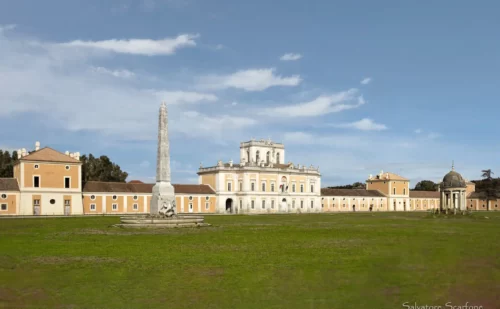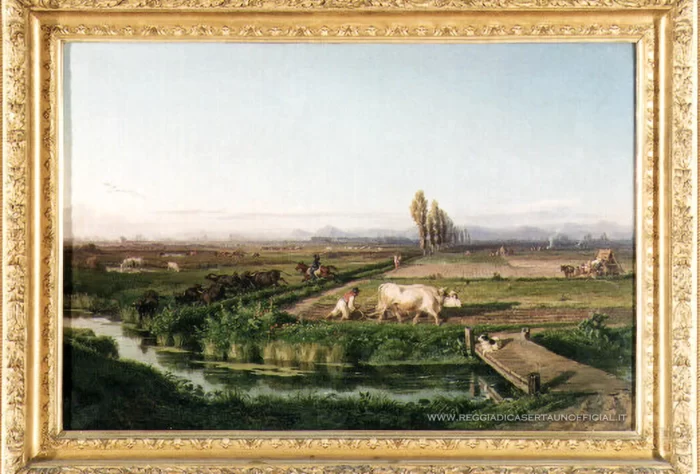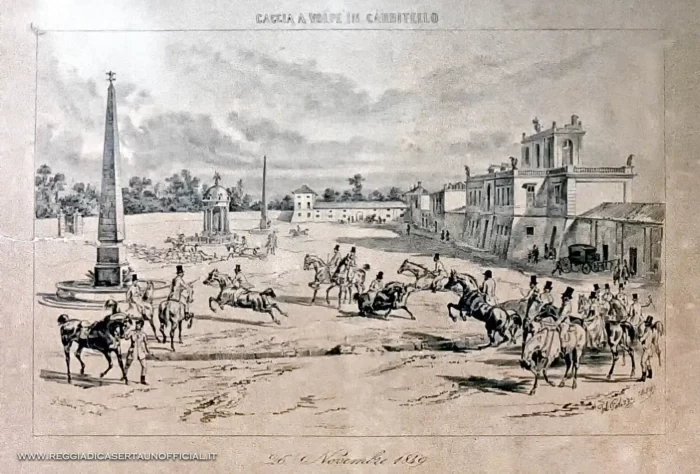The Royal Palace of Carditello was the Bourbons' farm
The Palace of Carditello was a Bourbon pride, and the place where pizza margherita and mozzarella were born.
The Royal Palace of Carditello was a huge farm of the Bourbons, where horses were bred, scientific zootechnical and food researches were carried out, and where pizza margherita and mozzarella were also born.
In ancient times
The first human settlements in the area date back to the period between the fourth century. B.C. and the 4th century AD where the Romans cleared the area, created a road network and started a reclamation of the marshes for agricultural purposes but, in the early Middle Ages, the area was abandoned and became marshy again. The subsequent emigration was due both to the barbarian invasions and to the fact that it was not rich in water despite being an area between very fertile areas. Due to the lack of tillage of the land, the extremely mild climate, the abundance of humidity, the intrinsic fertility of a soil of volcanic origin, a very characteristic vegetation and flora flourished throughout the region. In particular, the whole area was rich in beautiful bushes of wild roses that covered it entirely and, not surprisingly, the site of Carditello was formerly called "Mansio Rosarum", magion of roses.
The subsequent reclamation of which we have news took place by the work of Alfonso I of Aragon, King of Naples (1080-1134), who had to frequent Carditello not only as a famous hunter; in fact it is precisely from the times of the Aragonese that the fame of the zootechnical vocation of the Carditello estate begins, and of the breedings of purebred horses that were held here. After the Aragonese dynasty, Naples passed through the Spanish viceroyalty, until it reached the Bourbon period.
The Bourbon era
In this period not only the Real Defense of Carditello is formed, but it is appreciated and valued to such an extent by the rulers, that it becomes part of that special branch of the Bourbon Administration that dealt with the "Royal Sites" or "Royal Delights of Kingdom of the Two Sicilies ”, many of which were born during the first years of the Reign of Charles III, all within a short distance from the capital, Naples.
And in fact even before the idea of building the great Royal Palace in Caserta matured in the mind of Charles III, conceived as the center of a new capital of the Kingdom of Naples, passed to the Bourbon dynasty for the Treaty of Vienna (1738), one of the first care of the Sovereign, who was passionate about hunting to the point of considering it, in the last years of his life, the only remedy to overcome the fear of becoming a victim of madness, like his abulic father Philip V, was to acquire the patrimony of the It crowns a series of places particularly suitable for the exercise of this ancient activity.
The choice of the place, as it says in the Platea document, was made following the will of Charles III of Bourbon, to also start a breeding of thoroughbred horses; Carditello was in fact particularly suitable for this purpose both for the abundance of natural pastures and perhaps for the presence of an equine heritage already of moderate value.
This was the case for the "royal site" of Carditello whose territories, previously divided between numerous small and large feudal lords, religious institutes and other assignees, over the course of almost a century were merged into a single estate which in 1833 reached the maximum extension of moggia 6,275 equal to approximately 2,030 hectares, with a perimeter of over 16 miles.
The architect Francesco Collecini, one of the main pupils of Luigi Vanvitelli, the architect of the Royal Palace of Caserta, while he was arranging the palace of San Leucio, also took care of Carditello by sending him a branch of the Carolino Aqueduct, with the probable supervision by Vanvitelli.
In 1759 Charles of Bourbon left his son Ferdinando, who bought additional territories and completed the building in 1785.
Architecture of the Palace of Carditello
The design of the area was entrusted to the best pupil and collaborator of the royal architect Luigi Vanvitelli: Francesco Collecini. He designed a structure with sober and majestic elegance, partly a royal palace and partly a farm.
The structure, totally symmetrical, is composed of:
- a central building with two floors: on the ground floor there were kitchens, the armory and rooms for the staff, on the upper floor the areas for the sovereigns;
- on the sides and behind there are sheds for agricultural activities and livestock farms;
- at the corners there are eight towers used as workers' houses;
The ensemble strikes first of all for the elegance and proportion of the shapes, the sober colors, and the fascinating ovoid-shaped square in front has a structure and use similar to that of the circuses of ancient Rome: it is decorated with fountains, obelisks and a small circular temple, and was used for the races of the horses that were bred.
Two symmetrical staircases lead to the first floor, the one reserved for the Sovereigns, where there is a large reception hall for banquets, preceded by a hallway, two large living rooms and bedrooms. There is also a large chapel, which extends over the entire height of the building, with a balcony reserved for the Sovereigns and the Court.
The same artists who worked in the Palace put their hand to the decoration of the Palazzina di Carditello but, over time, they were taken up and modified over a long period of almost a century.
As in San Leucio, the court and the workers lived in close contact, as each environment is in close connection with the others.
The interiors of the Palace of Carditello
Over time they have been abandoned and looted, they are currently being restored. The remaining furnishings have been in custody in other museums for many years, including in the Royal Palace of Caserta.
The farm
The residence was immersed in a vast estate rich in woods, pastures and arable land, and extended over an area of 6,305 Capuan moggia, corresponding to approximately 2,100 hectares.
King Ferdinand IV, unlike his father, did not use Carditello only for hunting, he devoted himself with great passion to the creation of modern agriculture; it was in Carditello that he started an important dairy herd for the production and processing of cheeses, and imported other cattle breeds without however neglecting the local breeds and particularly the buffalo species.
Carditello, besides constituting a hunting reserve, where wild boars, deer, hares, foxes and waterfowl abounded, had also become a large model farm, from which all sorts of food were obtained for the needs of the Court.
Indeed, the company had to be well organized and tidy, and for the dairy cattle there were stalls scattered throughout the estate, the so-called "vacchereccia" and "bufaleria", while the eight warehouses that can still be seen today were used as stables for the important breed of horses that was being selected. The horses were selected for their size, strength and speed and for this purpose the large central riding school was created where training and running competitions were held. The competitions took place mainly on Ascension Day, but sometimes also on other occasions. It was on the occasion of the official inauguration of the Parish of Carditello, dedicated to the Ascension, in the year 1792, that Ferdinand IV instituted these solemn celebrations.
Since then, every year, on Ascension Day, many important people were invited to Carditello, all the people were celebrating, and in the afternoon the horse races took place which in a few years became famous in the area, and which had as a prize for the winners are the horses of the prestigious Carditello breed, thinner, but faster than the more famous one from Persano.
King Ferdinand IV loved Carditello in a special way because here, in addition to the leisure of hunting and agricultural interests, he had conceived and carried out one of the most important works that were dearest to him: the drafting of the laws for the Colony of San Leucio.
In the following years, and with the changes of sovereigns, the Carditello site remained substantially the same.
The birth of mozzarella and pizza
it is little known but mozzarella and pizza margherita were born thanks to the will of the Bourbons in the Carditello company.
A day of hunting in Carditello
A very vivid description of how a hunting party (boar) took place, precisely in Carditello, is found in a passage published in London in 1826 written by Lady Craven, guest with her husband, Margrave of Anspach, of King Ferdinand, and we like report it in full in the transcription of De Filippi:
"... the hunters gathered in a clearing surrounded by scrublands, and wild boars are brought out of the bushes and scrubs. Dogs are immediately thrown on to the poor beast; each hunter is armed with a pike and tries to hit the animal to the passage, while the dogs have already made their resistance in vain. The plain is beaten several times and when no more boar out of it the hunt ends and the clearing is littered with these killed beasts. Once the hunt is over, all gather around the king and with the pen in his hand, he waits for each hunting piece to be placed in front of him. Then he himself noted the weight of each boar, the names of those who had killed him, the date of the year and the day The beasts were torn off their fangs, washed and cleaned carefully, then placed them in many sheaths in a small piece of furniture built for them, and a tag with the name of each was attached to each of those trophies. and the hunter who had killed the beast and the date of the killing. Then the king sat down to eat a frugal meal ".
The abandonment after the Unification of Italy
With the advent of the Savoy family, the Carditello estate returned to being mainly a hunting reserve and the buildings, and among them particularly the central building less and less inhabited and more unattended, slowly but progressively deteriorated. It was a very complicated period for Carditello (riots, thefts, extortions), and when the Savoy family entrusted the "custody" of Carditello to one of the most dangerous criminals and Camorra in the area, the Palace began to be systematically stripped of valuable pieces of art .
The Savoys only sporadically attended the Carditello hunting estate, and this until 1919 when the estate was donated to the Opera Nazionale Combattenti, which donated a small part of the land to the veterans.
In 1924 the state expropriated 145 hectares of land to create a weapons and ammunition depot, and an accidental fire created an explosion that caused great damage to all the structures in Carditello.
In 1930 all the land was dismembered and sold. In 1968, restoration work began, financed by the Cassa per il Mezzogiorno and the Campania Region.
Therefore Carditello after the unification of Italy suffered a fate of abandonment and dismemberment similar to the Palace of Portici
Recent history of the Palace of Carditello
Later it was again abandoned and, over the years, was heavily sacked. In 2004 the Superintendency finally placed the Carditello Palace under protection, and in 2013, thanks to the will of the Minister of Culture Massimo Bray, it was purchased by the State and its restoration began.
Currently the structure is managed by the Carditello Foundation which is working on its restoration, so the site is not currently open to visitors except on special occasions.
Tommaso Cestrone, the Angel of the Palace of Carditello
If, despite the previous looting, today there is something left of this palace, it is due to the work of Tommaso Cestrone who, free of charge, took care of it by cutting the weeds, cleaning it and supervising it, even receiving death threats. Unfortunately, he died in 2013 before Minister Bray bought the estate, but he is remembered by all as the Angelo di Carditello.
His Facebook page
Although he died in 2013, his Facebook page is still visible as evidence of his great work of protection:
External Link


























